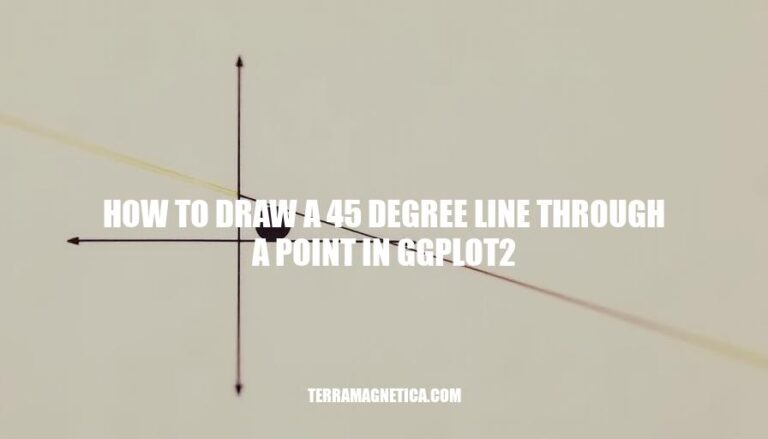


Learning to draw a 45-degree line through a point in ggplot2 is a valuable skill in data visualization. This technique helps in creating reference lines that can highlight trends, compare data points, and enhance the interpretability of scatter plots and other visualizations. By mastering this, you can make your data stories more compelling and insightful.
Here are the initial steps to set up ggplot2 in R:
Install ggplot2:
install.packages("ggplot2")
Load ggplot2:
library(ggplot2)
Prepare to draw a 45-degree line through a point:
# Example data
df <- data.frame(x = c(1, 2, 3), y = c(1, 2, 3))
# Create plot
ggplot(df, aes(x = x, y = y)) +
geom_point() +
geom_abline(intercept = 0, slope = 1) # 45-degree line
This will install and load ggplot2, and create a basic plot with a 45-degree line.
Here’s how you can create a basic scatter plot in ggplot2 and add a 45-degree line:
Install and load ggplot2:
install.packages("ggplot2")
library(ggplot2)
Create a basic scatter plot:
ggplot(data, aes(x = x_variable, y = y_variable)) +
geom_point()
Add a 45-degree line:
ggplot(data, aes(x = x_variable, y = y_variable)) +
geom_point() +
geom_abline(slope = 1, intercept = 0)
Replace data, x_variable, and y_variable with your actual dataset and variable names. This will create a scatter plot with a 45-degree line passing through the origin.
To draw a 45-degree line through a specific point in ggplot2, use the geom_abline() function with the appropriate slope and intercept values. Here’s how:
library(ggplot2)
# Example data
data <- data.frame(x = c(1, 2, 3), y = c(2, 3, 4))
# Define the point
x0 <- 2
y0 <- 3
# Calculate the intercept
intercept <- y0 - x0
# Plot with 45-degree line
ggplot(data, aes(x = x, y = y)) +
geom_point() +
geom_abline(slope = 1, intercept = intercept)
In this example:
geom_point() plots the data points.geom_abline(slope = 1, intercept = intercept) adds the 45-degree line through the point ((x_0, y_0)).To customize the 45-degree line in ggplot2, you can use the geom_abline() function. Here are some options:
Change Color:
ggplot(data, aes(x, y)) +
geom_point() +
geom_abline(slope = 1, intercept = 0, color = "blue")
Change Line Type:
ggplot(data, aes(x, y)) +
geom_point() +
geom_abline(slope = 1, intercept = 0, linetype = "dashed")
Change Thickness:
ggplot(data, aes(x, y)) +
geom_point() +
geom_abline(slope = 1, intercept = 0, size = 1.5)
Combine Customizations:
ggplot(data, aes(x, y)) +
geom_point() +
geom_abline(slope = 1, intercept = 0, color = "red", linetype = "dotted", size = 2)
These adjustments can help make your plot more visually appealing and easier to interpret.
Here’s a step-by-step example of drawing a 45-degree line through a point in ggplot2 using a sample dataset:
Install and load ggplot2:
install.packages("ggplot2")
library(ggplot2)
Create a sample dataset:
df <- data.frame(x = 1:10, y = 1:10)
Plot the data:
p <- ggplot(df, aes(x = x, y = y)) +
geom_point()
Add a 45-degree line through a specific point (e.g., (5, 5)):
p + geom_abline(intercept = 0, slope = 1, color = "blue") +
geom_point(aes(x = 5, y = 5), color = "red", size = 3)
This will plot your data points and add a 45-degree line (slope = 1) through the point (5, 5). The point (5, 5) is highlighted in red.
This is an essential skill for effective data visualization. This technique allows you to highlight specific points of interest, illustrate relationships between variables, and create visually appealing plots that convey meaningful insights.
geom_point.geom_abline.This technique is versatile and can be used to:
This will enable you to create more effective and engaging visualizations that help you tell a story with your data.